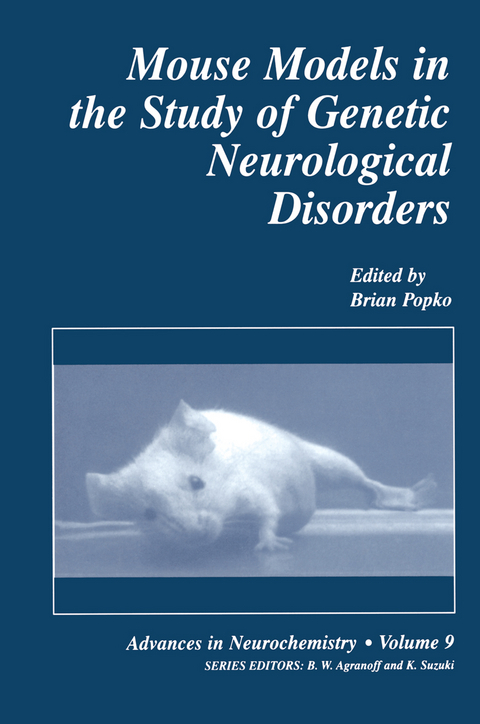
Mouse Models in the Study of Genetic Neurological Disorders
Kluwer Academic/Plenum Publishers (Verlag)
978-0-306-45965-8 (ISBN)
1 An Overview of Mouse Models in Neuroscience Research.- 1. Introduction.- 2. Naturally Occurring Mouse Models.- 3. Transgenic Models.- 4. Gene Targeting in Embryonic Stem Cells.- 5. Future Directions.- 6. Summary.- References.- 2 X-Linked Dysmyelination: Mouse Models of Pelizaeus—Merzbacher Disease.- 1. Pelizaeus—Merzbacher Disease and X-Linked Spastic.- Paraplegia.- 2. Myelin Proteolipid Protein (PLP/DM20).- Acknowledgments.- References.- 3 Charcot—Marie—Tooth Disease: Pathology, Genetics, and Animal Models.- 1. Introduction.- 2. Charcot—Marie—Tooth Disease.- 3. Animal Models for Charcot—Marie—Tooth Disease.- 4. Summary and Outlook.- Acknowledgments.- References.- 4 Mouse Mutations in the Study of Cerebellar Development.- 1. Cerebellar Development.- 2. Cerebellar Mouse Mutants.- 3. Conclusions.- Acknowledgments.- References.- 5 The Role of Neurotrophic Factors in Development and Neurodegenerative Disorders.- 1. Introduction.- 2. Historical Review.- 3. The NGF and GDNF Families of Neurotrophic Factors.- 4. Regulation of Specific Populations of Peripheral Neurons by Neurotrophin and GDNF Family Members.- 5. Hereditary Conditions Associated with Growth Factor Receptor Mutations.- 6. Multiple Trophic Factors Regulate the Development of Some Peripheral Neurons.- 7. Regulation of Survival of CNS Neurons.- 8. Conclusions.- References.- 6 Transgenic Mice with Neurofilament Abnormalities.- 1. Introduction.- 2. Neurofilament Structure and Function.- 3. Transgenic Mouse Models with Neurofilament Accumulations.- 4. Defective Axonal Transport in NF-H Transgenic Mice.- 5. Factors that Can Potentially Induce the Accumulation of Neurofilaments.- 6. A Link between SODI and Neurofilaments?.- 7. Prospects.- Acknowledgments.- References.- 7 Mouse Models of AmyotrophicLateral Sclerosis.- 1. SOD1 Activity and ALS.- 2. Linking Motor Neuron Growth and Death: Neurofilaments, Axonal Disorganization, and Motor Neuron Disease.- 3. Axonal Transport.- 4. Neurotrophic Factors, Bcl-2, and Apoptosis.- 5. Glutamate Excitotoxicity.- 6. Summary/Conclusions.- References.- 8 Transgenic Mouse Models of Cag Trinucleotide Repeat Neurologic Diseases.- 1. Introduction.- 2. Pathology and Neurological Alteration in Transgenic Mice with Expanded CAG Tracts.- 3. CAG Repeat Instability in Transgenic Mice.- 4. Conclusions and Closing Comments.- References.- 9 Alzheimer’s Disease and Genetically Engineered Animal Models.- 1. Introduction.- 2. Alzheimer’s Disease.- 3. Principal Risk Factors.- 4. Genetically Engineered Animal Models.- 5. Conclusions.- Acknowledgments.- References.- 10 Model of Genetic Susceptibility to Late-Onset Alzheimer’s Disease: Mice Transgenic for Human Apolipoprotein E Alleles.- 1. Genetic Classification of AD.- 2. APOE Susceptibility Gene for AD.- 3. APOE in the Periphery.- 4. APOE in the Central Nervous System.- 5. APOE in the Peripheral Nervous System.- 6. APOE and Pathogenesis of AD—Extracellular Role.- 7. APOE and Pathogenesis of AD—Intracellular Role.- 8. Human Pattern of Neuronal and Glial Localization of APOE.- 9. Apolipoprotein E and Oxidative Injury.- 10. Genetic Models of APOE as a Susceptibility Gene in AD.- 11. APOE Gene Inactivation Model.- 12. Consideration of Genetic Background in Analysis of APOE “Knockouts” and Transgenes.- 13. APOE Transgenic Model with Human Regulatory Sequences.- 14. APOE Transgenic Model with Nonhuman Regulatory Sequences.- 15. APOE Targeted Replacement Animals.- 16. Current Models for the Effect of APOE Alleles on Susceptibility to AD.- 17. Summary/Conclusions.- Acknowledgments.-References.- 11 Lysosomal Disorders.- 1. Introduction.- 2. Naturally Occurring Mouse Models.- 3. Artificially Generated Mouse Models.- 4. Utility of Experimental Animal Models.- 5. On the Horizon.- Acknowledgments.- References.- 12 Neurological Implications of the Genetic Mouse Models for Human Phenylketonuria and Hyperphenylalaninemia.- 1. Introduction.- 2. Earlier Efforts to Produce Mouse PKU Models.- 3. The Genetic PKU Mouse Program.- 4. Future Studies Enabled by the Genetic Mouse Model for.- Human PKU.- References.- 13 Mouse Models of Down Syndrome.- 1. Introduction.- 2. Location of Human Chromosome 21 Genes in the Mouse Genome.- 3. History of Mouse Trisomy Models for DS.- 4. Mental Retardation and Neurological Deficits.- 5. Summary.- Acknowledgments.- References.- 14 Modeling Epileptic Disorders in Mice.- 1. Introduction.- 2. Monogenic Epilepsy Models in Mice.- 3. Multifactorial Epilepsy Models in Mice.- 4. Genetic Models of Spontaneous Lethal Epilepsies and Status Epilepticus.- 5. Mapping Epilepsy Genes in the Human and the Mouse.- Acknowledgments.- References.
| Erscheint lt. Verlag | 28.2.1999 |
|---|---|
| Reihe/Serie | Advances in Neurochemistry ; 9 |
| Zusatzinfo | XVIII, 366 p. |
| Verlagsort | New York |
| Sprache | englisch |
| Maße | 155 x 235 mm |
| Themenwelt | Studium ► 1. Studienabschnitt (Vorklinik) ► Physiologie |
| Studium ► 2. Studienabschnitt (Klinik) ► Humangenetik | |
| Naturwissenschaften ► Biologie ► Humanbiologie | |
| Naturwissenschaften ► Biologie ► Zoologie | |
| ISBN-10 | 0-306-45965-5 / 0306459655 |
| ISBN-13 | 978-0-306-45965-8 / 9780306459658 |
| Zustand | Neuware |
| Haben Sie eine Frage zum Produkt? |
aus dem Bereich


